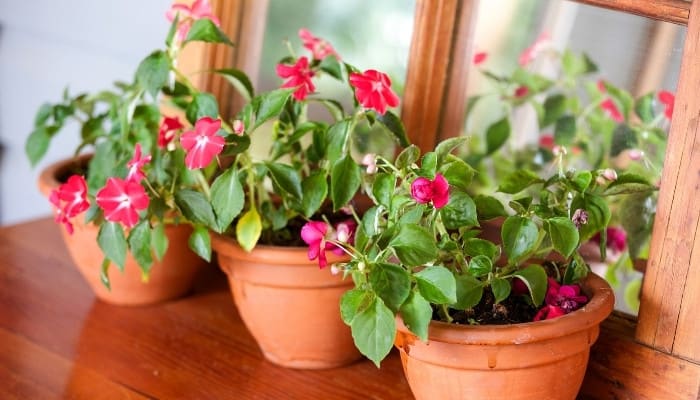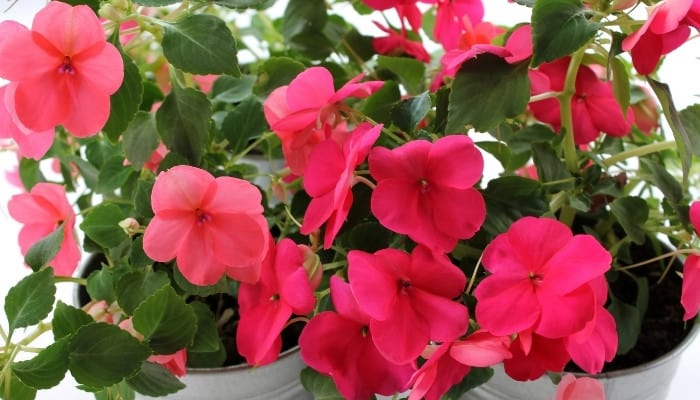Impatiens, or commonly known as “busy Lizzies,” are widely considered the top choice for bedding plants in the United States.
Luckily, with a few care tricks, this charming flowering plant with dark-green foliage set against bold blooms of pink, red, purple, and white can just as easily be enjoyed inside your home too.
Can you grow impatiens indoors? Impatiens flowers can be grown indoors successfully when they are kept in a warm, bright environment of 65-70°F that can maintain moderate humidity levels. They’ll perform best when grown in moist, not waterlogged, soil, so careful watering and a well-draining soil medium is a must.
Their name references the eagerness with which their ripe seed pods burst open, not their demanding, high-maintenance nature.
By observing the following pro care tips and steps for the best blooms, you can invite a touch of summer cheer to your indoor space throughout the seasons!
Keys for Successfully Growing Impatiens Indoors
Impatiens can be grown from seed, but this tricky method requires specific conditions for indoor success.
Growers at Gardener’s World recommend buying impatiens plug plants (ready-to-pot seedlings/cuttings) in the spring for a more straightforward introduction to growing them in your home.
Container & Soil
“Impatiens love to spread out so choose a pot size of about 5 inches to plant your store-bought Impatiens plugs” advises Homesweet Homegrown author Robyn Jasko.
As traditional potting soil alone tends to be quite heavy on their delicate roots, use a lighter mix of 1/3 peat moss, 1/3 perlite (granular rock to increase soil aeration), and 1/3 potting soil for good drainage quality.
Light
Placing your impatiens in bright, indirect light near a south-, east-, or north-facing window will be ideal.
Though they are tolerant of low light, the darker winter months will take a toll on flower production and produce weakened leggy stems, so consider using supplemental grow lights specifically for winterizing for successful growth.
These fully adjustable grow lights with three timer settings are ideal, and with four separate arms, you can provide light to multiple plants at once.
Temperature & Humidity
Stick to a range between 65-70°F (18-21°C) in the day and 50-55°F (10-12°C) at night, though ideally aim to prevent temperatures dropping below 55°F as this provides a steadier growing environment to encourage blooms.
Keep your impatiens clear from drafts or cooling vents and maintain 50% humidity levels by utilizing a humidifier, like this ultra-quiet model, or a pebble tray.
(Here is how to make your own pebble tray.)
It’s also a good idea to mist the leaves once daily if temperatures exceed 75°F.
Watering
Water your impatiens until it drains from the pot holes, and only water again once the topmost soil layer feels dry.
Observing this rule will keep the soil evenly moist but not soggy as waterlogged soil can lead to fungal diseases.
Fertilizer
Regular fertilizer bodes well for impatiens flowering, but plant hobbyist and creator of Maine Garden Ideas Nanette Richford advises going easy to prevent a case of “healthy, green foliage but few blooms.”
Apply water-soluble houseplant feed, like this highly rated food with micronutrients, “once a month throughout spring and summer.”
Tips for Getting More Blooms on Your Impatiens

1. Aim To Provide 2-4 Hours of Sunlight Each Day
Impatiens were thought of as shade-loving plants, but newer cultivars have been bred to need more light than their traditional counterparts.
The Home & Garden Information Center of Clemson University, South Carolina suggests impatiens will:
“thrive when exposed to the morning sun and afternoon shade or in a location that gets 2-4 hours of filtered light to prevent leggy stems and encourage profuse blooms.”
2. Test & Adjust the Soil pH to Impatiens’ Preferred Levels
Did you know that impatiens prefer slightly acidic soil (around 5.5 to 6.5)?
Too high or low levels can keep them from absorbing nutrients, affecting their flowering ability and the extravagance of the blooms.
To potentially increase your impatiens bloom count, test the soil’s pH with a tester like this one that also measures moisture and light levels.
If it reads as more acidic (5.0 or lower), you can add lime to raise the acidity slightly. For 5-6 inch pots, adding 1 tablespoon of dolomitic lime (find it here) to the potting mix should suffice.
3. Routinely Prune & Deadhead Spent Flowers To Promote New Blooms
Once each flower on your impatiens plant has fully bloomed and faded, pinch them off at the top of the stem and continue doing so throughout their spring to summer growing season to encourage new blooms to emerge.
Pruning overgrown, leggy stems with clean, pruning shears or sharp kitchen scissors will also stimulate healthier, fuller growth.
4. Water Only When Necessary To Prevent Moisture Stress
Moist soil is the perfect environment for impatiens – any damper than this can cause moisture stress, resulting in the abortion of flower buds altogether.
Remember to water your impatiens plants only once the top few inches of soil feel dry to the touch.
Also, don’t let them stand in water once they have been watered.
Let the water fully drain from the pot holes each time, empty water saucers as necessary, and ensure your soil medium is made from a well-draining formula as recommended above.
Related Questions:
Do Impatiens Come Back Every Year?
Impatiens come in both annual (one season) and perennial (year-round) varieties.
The perennial species Impatiens walleriana survives outdoors in USDA plant Hardiness Zones 10-11 and can be moved indoors for frost protection before being re-planted in the spring for continued blooms.
In ideal conditions, many annual impatiens will self-seed. The new plants will emerge in spring in the vicinity or original plantings.
Do Impatiens Bloom All Year Indoors?
Year-round blooming on indoor impatiens is possible with great care.
Keep them in a bright location with the aid of grow lights if necessary, and keep them away from heat sources over winter to prevent them from drying out.
Give them 2 inches of water each week in winter, and consider fertilizing twice monthly, provided you dilute the solution strength by half.
Conclusion
To summarize, you can enjoy growing this traditional bedding plant indoors by making an effort to maintain a comfortably warm, humid environment; providing enough filtered, bright light; and by using a light soil mix that encourages sufficient drainage.
Indoor success with your impatiens also relies on careful watering to prevent moisture stress to the buds and a boost of light but consistent fertilizer to bring out the flower power!
Sources:
https://www.gardenersworld.com/how-to/grow-plants/how-to-grow-impatiens/
http://www.gardening.cornell.edu/homegardening/scene237b.html [Growing Guide – Impatiens, Cornell University]
https://homeguides.sfgate.com/growing-impatiens-indoors-65894.html
https://redheadcandecorate.com/2016/03/indoor-impatiens/
https://homeguides.sfgate.com/can-bring-impatiens-inside-70941.html
https://www.gardeningknowhow.com/ornamental/flowers/impatiens/keeping-indoor-impatiens-plants.htm
https://www.nature-and-garden.com/gardening/impatiens.html
https://thepracticalplanter.com/impatiens-care/
https://www.aylettnurseries.co.uk/product/indoor-plant-of-the-month-new-guinea-impatiens/
https://www.youtube.com/watch?v=vg2IK45rUyM [‘How to Plant Impatiens in a Container : Indoor Planting’ – Homesweet Homegrown, Robyn Jasko]
https://www.youtube.com/watch?v=fgJgjxhGim4 [‘How to Keep Impatiens Alive Indoors Through the Winter? : Indoor Planting’ – Homesweet Homegrown, Robyn Jasko]
https://homeguides.sfgate.com/impatiens-perennials-75044.html
https://www.burpee.com/article10007 [Growing Impatiens as Houseplants’, Burpee Gardener’s Advice]
https://impatiens.wordpress.com/2009/10/02/growing-impatiens-indoors-during-winter/
https://homeguides.sfgate.com/impatiens-plants-buds-but-wont-bloom-80690.html

